Dogue de Bordeaux: description of the breed, nature and subtleties of the content
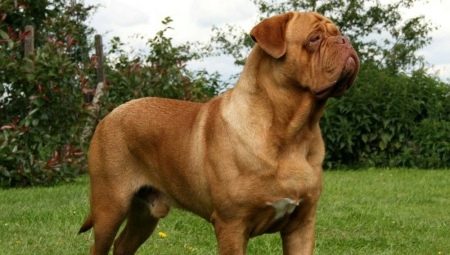
Dogue de Bordeaux is very often chosen both by the regulars of international exhibitions and by ordinary people who dream of a pet. This breed is rather difficult, and to establish relations with a previously fighting dog is possible only with a calm person with a strong character... In addition, the dog does not like loneliness, and therefore it is not suitable for workaholics who are absent from home all the time. When purchasing a mastiff, it is important to know in advance about the nature of the future pet, the conditions for caring for him and the rules of feeding.

Origin of the breed
Dogue de Bordeaux, aka French mastiff, has a very vague origin. Dog handlers have as many as three versions, and none of them is still official. According to the first theory, the mastiffs separated from the bulldogs. The second connects the Dogue de Bordeaux with the Tibetan Mastiffs. Finally, the third, the most famous and popular theory, holds the position that the Bordeaux mastiffs descended from the fighting ancient Alans, common among the French.
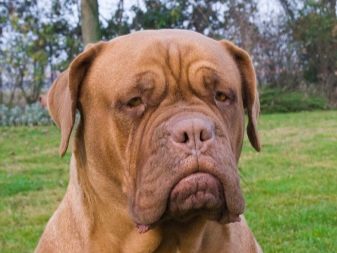
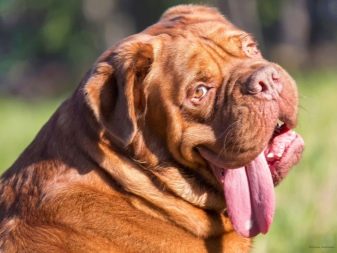
One of the oldest hunting breeds in France has been well described in a book published by Gaston de Foix back in the 14th century. The ancestors of the French mastiffs were used to bait wild boars and other large animals, guard livestock, transport meat and participate in dog pits. Great Danes of that time were divided into three varieties, very different in appearance. Not only the color or size of the head could be different, but even the bite. The very name "Dogue de Bordeaux" took root only in 1863, and before that the breed was always called "French Mastiff".
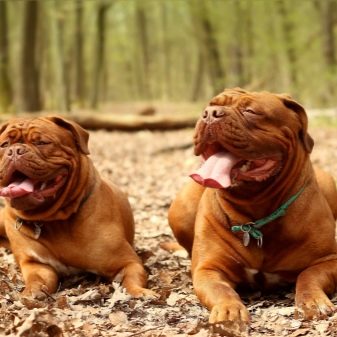
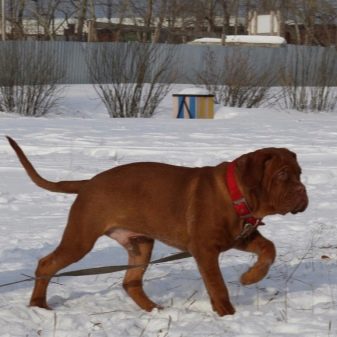
The first Dogue de Bordeaux breed club was formed in 1924.The establishment was created in order to restore the number of dogs, which was significantly reduced after the First World War. The next significant drop in numbers occurred after World War II., since feeding rather large dogs in wartime proved to be an impossible task. Many Great Danes were put to sleep by the owners themselves. The restoration of the breed began to be actively carried out in the 1950s. In the 1990s, the breed gained fame all over the world and began to be actively imported to other countries.
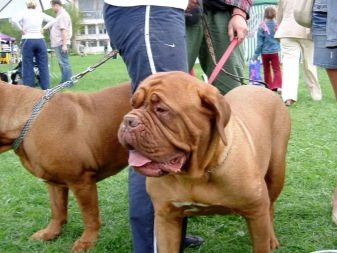
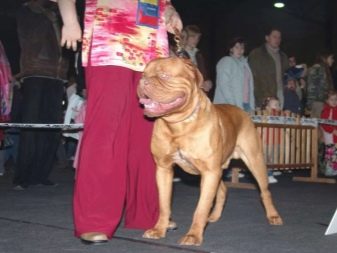
Description
Characteristics of Dogue de Bordeaux mainly contains information about the appearance of dogs. Although modern dogs have retained some of the features of their overly aggressive ancestors, they look a little different. French Mastiff puppies have soft features that become more pronounced over time. The dog looks massive and muscular, but rather squat. The weight of males can reach almost 90 kilograms, and their height is 68 centimeters. As for the females, their dimensions are practically the same: their height reaches 66 centimeters at the withers.
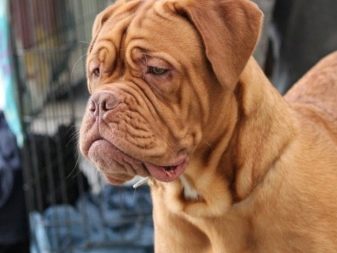
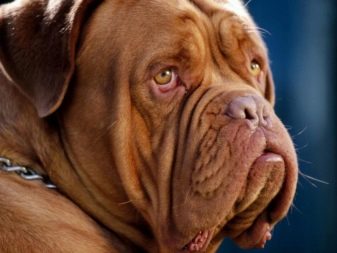
According to the standards, the weight of the male cannot be less than 50 kilograms, and the weight of the females is not less than 40 kilograms. French mastiffs live from 10 to 12 years, up to a maximum of 14 years, which cannot be called a long lifespan.
On the exterior, it is customary to distinguish three classes of French mastiffs. The first is the show standard, which means animals with ideal conformation characteristics. Such a dog participates in exhibitions and is also used for breeding. The second class is called the brid-standard. Dogs of this class have minor deviations from the ideal, and therefore are also used for breeding. Finally, there is the pet standard class. Such dogs are not used for breeding development and rarely participate in exhibitions, since there is no point in this. The Dogue de Bordeaux is simply a pet, loyal and intelligent member of the family.

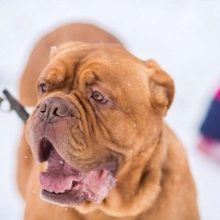

Experts identify 7 individual exterior indicators, which determine the class of the animal. The muscles of the cheeks and cheekbones should be developed, and the eyes, located under the bulging forehead, should be widely spaced. The ears are quite close to the muzzle, ideally reaching the ends of the eye line. The loin of the dog is wide and powerful, and the chest is 20-30 centimeters in circumference higher than the height. Finally, sufficient development of intuition and facial expressions is important.
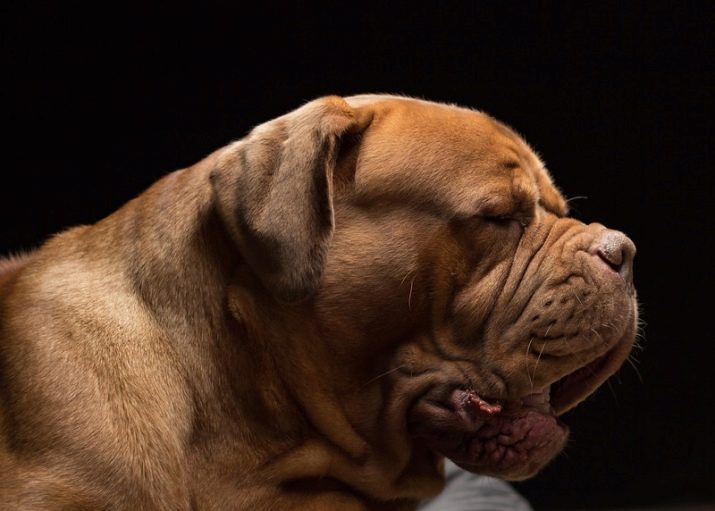
According to the main breed standards, weight ranges from 45 kilograms in the case of medium-sized females up to 90 kilograms in the most powerful males. Height at the withers reaches from 58 to 68 centimeters. The color can be exclusively red, and the general appearance is most consistent with the classic description of the representatives of the breed.
Character
The character of the dog, surprisingly, is quite calm and measured. The Dogue de Bordeaux is smart and sincerely devoted to its owners. He does not tolerate separation and being alone for a long time, he is very bored because of this and is always ready to protect his owners. but the main owner of the mastiff is still one - his dog chooses from the household, most often giving preference to a person with a calm character. With the "leader" of the family, the dog is on an equal footing, and the rest of the inhabitants of the apartment is slightly patronizing, friendly and even tender. Mastiff enjoys communication with children and he is always ready to spend time in games, but not too active.
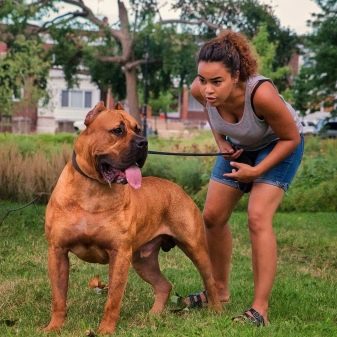
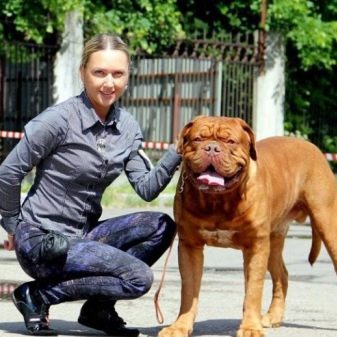
The dog may be aggressive towards strangers, but will not attack for no reason. The dog can bark loudly, but such a "gesture" should be considered as a warning. It is important to mention that Great Danes are considered a direct threat to people under the influence of alcohol., therefore, the very smell of ethyl alcohol can serve as a signal for an attack.French Mastiffs live quite comfortably with other pets and, with proper training, even with dogs of the same sex. However, animal friendliness does not extend to other people's pets.
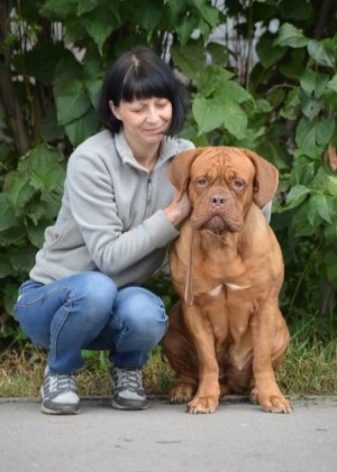
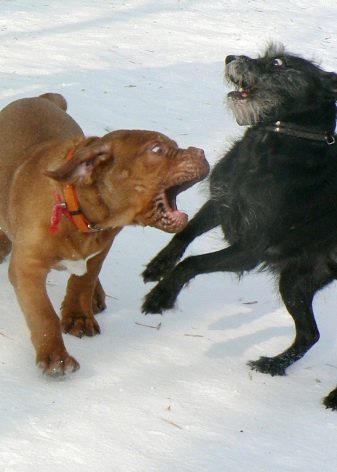
Training is carried out taking into account the characteristics of the character. Having received the command, the dog will first think it over, but after that it will begin to carry it out. At this moment of reflection, it will be completely meaningless to tell him something else. Great Danes are hardy, but a little lazy and rather stubborn. Having discovered the weak point of its owner, the dog will begin to use it without a twinge of conscience. The training of this breed will be successful if you do not use rude methods and shout, but use the right motivation.
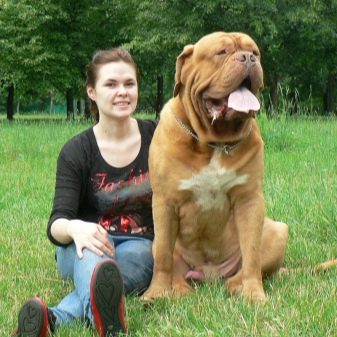
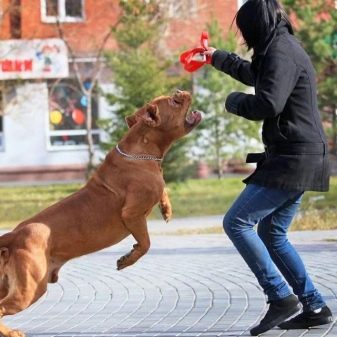
Appearance
According to the standard, the Dogue de Bordeaux is a large dog. His head is large, his chest is wide, and his body is rather stocky. The muzzle looks wrinkled due to the many folds on both sides. The short nose is slightly upturned, and the lower jaw protrudes forward. Delicate ears are crowned with curled edges. Oval, wide-set eyes range in color from black to beautiful brown. The expression on the face looks unhappy, which, by the way, does not at all speak about the true emotions of the dog. The tail has a crescent shape, and the limbs themselves are powerful and stable. The color of the French Mastiff is red, but the shade also varies from light, almost yellow, to dark brown. The mask is painted black or brick. The dog's coat is thick, monotonous, but often white spots are found on the chest.
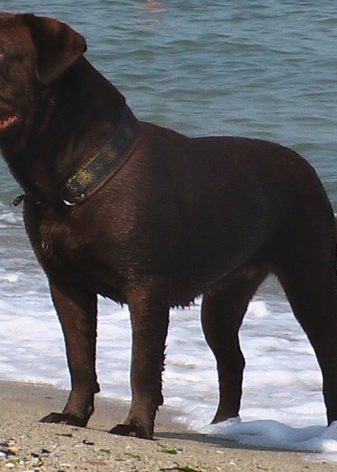

Selection recommendations
Dogue de Bordeaux are acquired at a young age, when they look like charming fat belly with shiny fur. Getting acquainted with them in the nursery, it is important to see how the babies move. A healthy dog has no problem climbing on paws that do not braid or move apart. It is necessary to check the presence of a veterinary passport, as well as affixed vaccinations. In addition, it is important that 10 days have passed since the last vaccination.
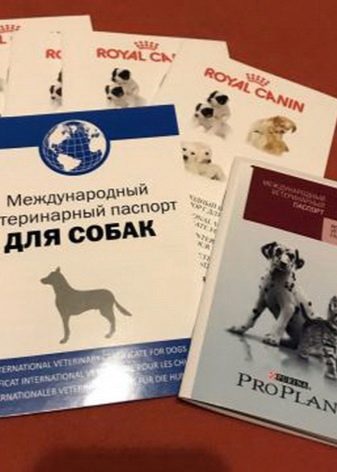
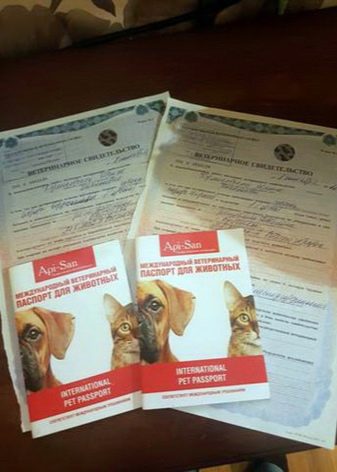
The puppy should be 3 months old - experts do not recommend taking him away from his mother earlier. When choosing between a female and a male, you need to think about whether your own leadership qualities are enough for training. The owner should clearly dominate the relationship with an independent male puppy, but the girl, although more obedient, often shows cunning.
In the event that it is planned to participate in exhibitions with a mastiff, the choice cannot be based only on the appearance of the animal and one's own emotions. It is necessary to study the breed standard, check the documents of the parents, evaluate several litters and it is better to make a purchase with a specialist. The nursery must have a proven track record and a sufficient number of successful “graduates”. When coming up with a nickname for a Great Dane, it is better to give preference to proudly sounding names that personify all the positive qualities of this breed. The price of a puppy can range from $ 500 to $ 1200. The determining factors are gender (females are always more expensive than males), pedigree, compliance with the standard and other indicators.
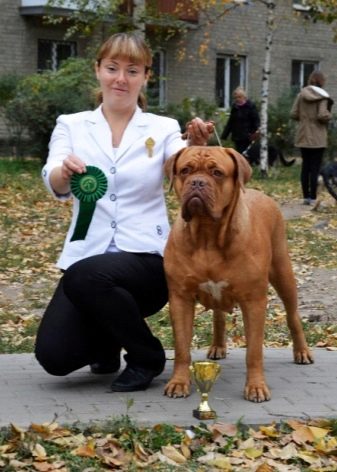

What and how to feed?
An adult dog perfectly accepts both natural food and ready-made feed. In the first case, the diet is made up of lean meat, sometimes stringy, meat offal, cereals and vegetables, fresh and boiled. From meat, beef, chicken and turkey are suitable, in addition, tendons and cartilage should not be excluded from the diet. A couple of times a week, the mastiff should be fed with sea fish, but always cooked and stoned. The addition of skim milk or cottage cheese, as well as raw eggs is encouraged.
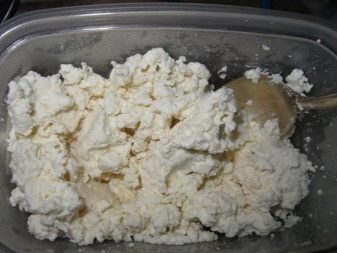
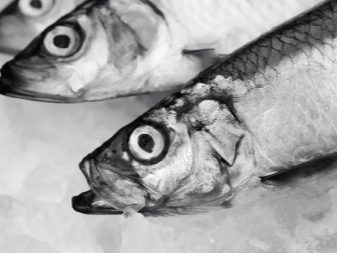
The list of vegetables for a mastiff is quite extensive. It includes foods such as cabbage, beets, cabbage, and pumpkin.It is better not to give potatoes to the dog, since this root crop is poorly absorbed by the body. The portion should satisfy the dog's food needs, but not be excessive, so as not to provoke the development of diseases. It will be convenient to cook porridge for your pet and add meat with raw, finely chopped vegetables to them.

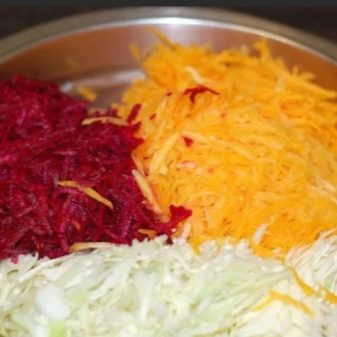
Feeding with dry food is only possible with the purchase of a high quality product sold in a specialized store. Products should be designed specifically for large breeds and be saturated with all essential vitamins and minerals. The amount of food offered per day is determined according to the size of the animal, its activity, age, health status and functioning of the gastrointestinal tract. When the Dogue de Bordeaux becomes overweight, it is necessary to reduce the amount of portions and increase the amount of physical activity.

Surprisingly, they eat quite a bit of Bordeaux mastiffs - a portion weighing 200 grams is quite enough for them. Overfeeding in this case turns out to be critically dangerous, since excess weight harms the internal organs. Having decided on the type of food, it must be adhered to further, in no case mixing dry food with natural products.

It is important that the Great Dane always has access to clean drinking water, which is better settled for 6-8 hours. It is additionally recommended for puppies to be given vitamin complexes, vegetable oils and other useful additives, for example, bone meal.
Adult dogs are usually fed twice a day, while babies will need 3 to 4 meals a day. Thinking over the diet, you should adhere to the formula: 30 grams of protein per kilogram of animal weight. At the same time, approximately 30% of the dishes should consist of cereals, fruits and vegetables. The list of foods prohibited for this breed includes sweets, flour, river fish, mushrooms, tubular bones and dishes with an abundance of salt and spices. In general, it is worth adhering to a rather monotonous and even boring diet, the main characteristics of which are lightness and usefulness.
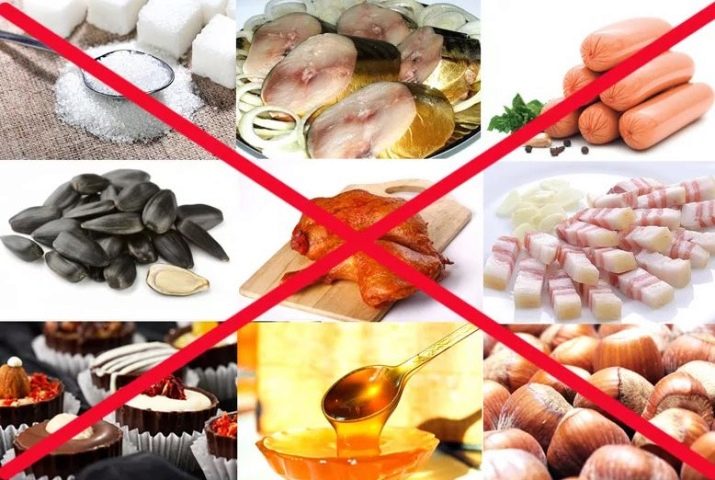
How to take care of it properly?
It is customary to keep the Dogue de Bordeaux in a house or apartment. If the owners plan to settle the dog on the street, then the kennel must be heated throughout the year. However, it is better to visit the street for walking, training and jogging. The floor in the place where the dog will sleep at home should be moderately warm, since the cold negatively affects the rather weak joints of the dog. It is not allowed to lock the dog in the aviary.
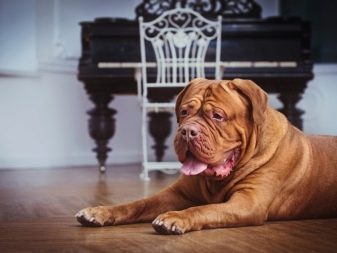
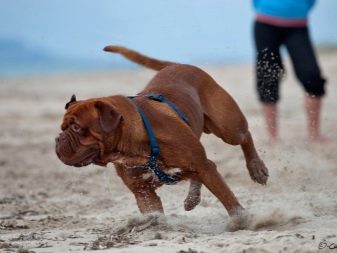
It is recommended to comb the pet every week. For this purpose, a special hard brush or glove made of silicone or rubber is used. The mastiff sheds moderately, as the coat is rather short. Thanks to combing, it turns out to remove ingrown hairs and already dead skin cells.
After eating, it is better for the mastiff to clean the folds on the face. This can be done easily with a regular cloth or wet wipe. Periodically, it is important to examine the condition of the eyes and eyelids, as well as to clean them with a cotton pad soaked in a mixture of tea brew and heated drinking water. Do not forget about your teeth - special chewing sticks are perfect for hygiene.sold in specialized stores. In addition, teeth can be cleaned with a special brush and toothpaste. The claws are trimmed monthly or biweekly using a guillotine claw, and the sharp edge is filed. After a walk, experts advise to wash the paws and even coat with vegetable oil.

It is customary to clean the ears up to 3 times a week with a cotton swab soaked in lotion, but it is still better to check them daily. If the owner detects redness, inflammation, or excess sulfur, you should immediately consult a doctor.It is recommended to evaluate the condition of the pads of animals that are prone to cracking from time to time. Often it makes no sense to bathe your dog, as dry brushing is enough. A couple of full-fledged water procedures are the norm approved by specialists. The frequency of bathing is also determined based on the level of contamination of the dog. You should use a special veterinary shampoo and warm water, as hot water can dry out the skin.
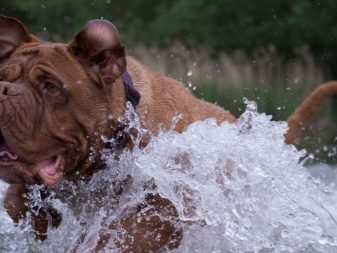

By the way, do not forget that the Dogue de Bordeaux tolerates high temperatures very badly, so you should go for a walk in the summer with a bottle of water. French mastiffs do not particularly welcome overly active pastime, so physical activity should be medium. In principle, a brisk walk twice a day is enough to prevent obesity. It is imperative that you take your pet out with a muzzle. During outdoor activities, it is important to avoid jumping from a height, as the animal easily injures the joints and ligaments.
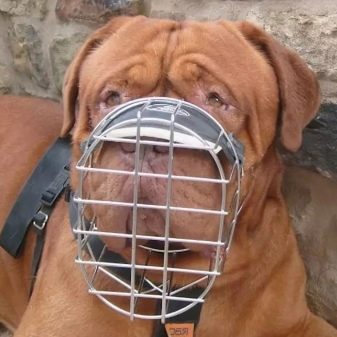
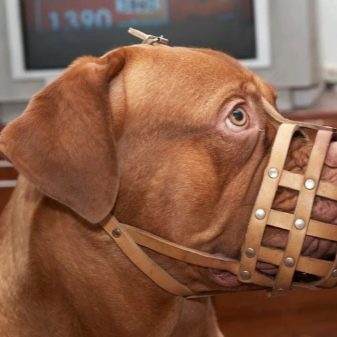
The care procedures for the Dogue de Bordeaux also include regular vaccinations, which can prevent serious diseases. It is important to treat wool from ticks and fleas, after consulting with a specialist on the choice of a product.
Separately, you should talk about the health of your pet. Dogo de Bordeaux are prone to certain diseases. A feature of the skull leads to breathing problems, such as shortness of breath. It is important for the dog not to overheat and not be actively spending time in the hot season. In addition, there are allergies, dysplasia of the hip or elbow joints, and in adulthood, the appearance of tumors, up to cancer. Females often have difficulties during childbirth. However, most of the problems are still the result of improper care or lack of timely vaccination.
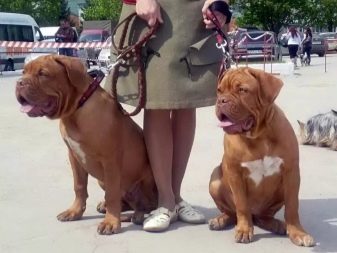
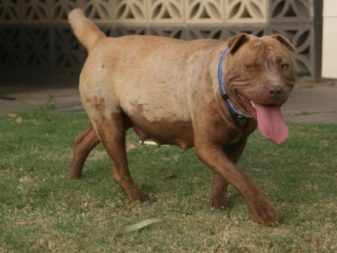
How to educate and train?
The upbringing and training of Dogue de Bordeaux puppies begins from the second or third month of life. The first step is the process of socialization. The dog needs to get used to the leash, muzzle and collar. It is important to take her out to the crowded and busy streets, let her interact with people and animals. In addition, it is important for the dog to instill trust in the world around him. The owner is advised to take the pet in his arms from time to time, shake it, stroke it and create positive emotions.

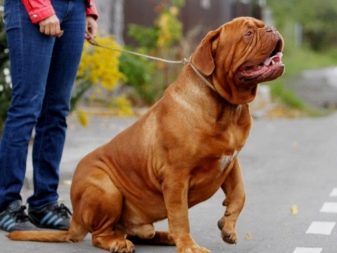
The direct training of teams occurs gradually. The first lessons should be simple and short-term, then their duration and complexity should be increased. Training should alternate with active games and must be rewarded with goodies if the task is successfully completed. When working with a puppy, it is important to be calm, patient and willing to wait., while the pet ponders what the owner wants from him. Ideally, a training program should be thought of with a professional who can also help build a long-term and mutually beneficial relationship between humans and animals.


The negative features of the French Mastiff include excessive obsession, so you should try to eradicate it. In addition, a good solution would be to wean the animal from jumping on a person, putting its paws on the chest, since, having reached a weight of tens of kilograms, this will create significant inconvenience. Getting the dog to do something is considered a failure. It will be much more effective to try to interest or motivate her. During training, a person should not raise his voice, use rudeness or harsh tone. An animal, feeling negative, begins to feel bad, its motivation drops dramatically. If the pet is indulging, then he needs to be reprimanded in a calm tone, and then offer to repeat the command.
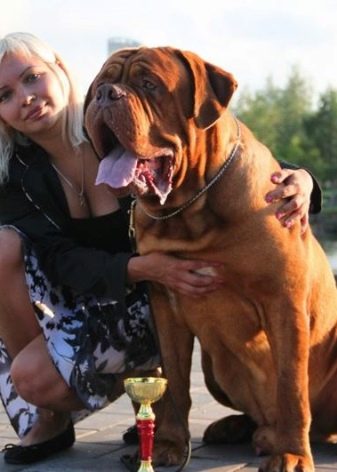
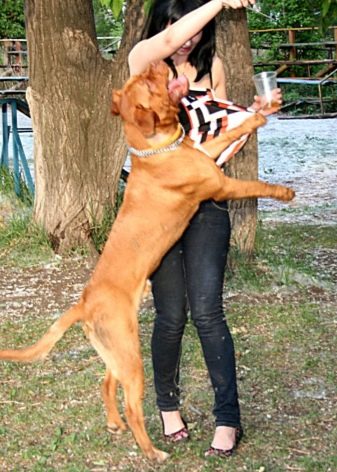
One of the important components of training is to teach how to calmly walk on a leash, without dragging the owner forward. In no case is it also worth encouraging aggression, since it is almost impossible to cope with an uncontrollable dog that has lost his temper.
Breeding
The key to breeding Dogue de Bordeaux puppies is the presence of a good breeding female. She must be healthy, large and thoroughbred. Indicators such as having outstanding ancestors and proper lineage are also important. The breeder must learn the standard by heart and be able to apply it. In addition to the appearance and health of the dog, its character is also important. You should not rely, for example, on a very attractive, but stupid or cowardly dog.
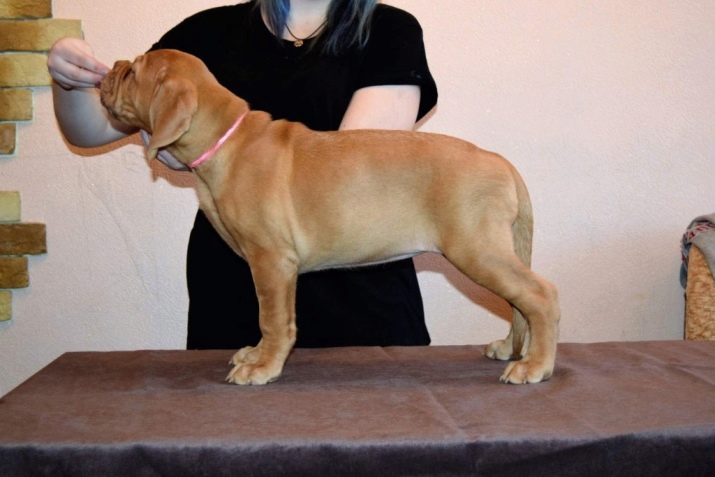
In general, the main condition for the successful breeding of representatives of this breed is the preliminary study of a large amount of information, the ability to seek out data, check reliable sources and be critical of them. Still, it should be mentioned that the breeding of large and sometimes aggressive animals should be carried out by a person who has not only a sufficient amount of knowledge, but also experience. Relatively recently, a tragedy occurred in the Moscow region, when it was the Dogo de Bordeaux that attacked and bitten their mistress to death. Despite the fact that the woman was a professional who often attends international exhibitions and receives awards, a terrible incident still happened.
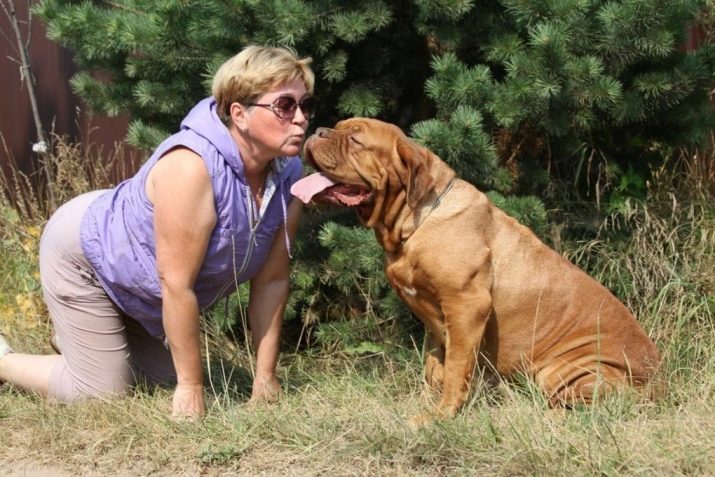
Reviews
Regarding the Dogue de Bordeaux, their owners most often speak out positively, negative comments are quite difficult to find. One of the reviews says that cooperation with a reliable breeder made it possible to choose a loyal and intelligent dog that loves to communicate with the owners and play, but at the same time shows itself perfectly at various exhibitions. The three-year-old mastiff even befriends the cat and sleeps with it. Friendship with other pets, by the way, is quite often mentioned. Another housewife says that a girl who has barely reached the age of one year not only loves her, but is always ready to protect her from trouble. Among the positive qualities of the breed, calmness, intelligence and devotion are distinguished.
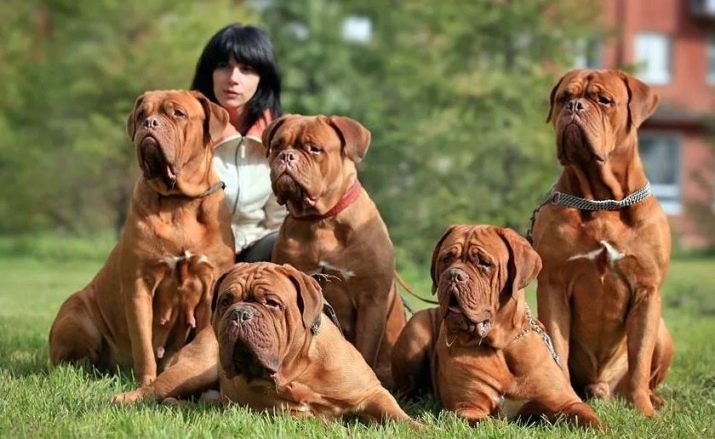
Caring for a French Mastiff is pretty simple. He does not eat as much as it might seem, he walks calmly and does not rush on birds or bicycles, does not bark for no reason and is perfectly placed even in an ordinary apartment of a small area. The main disadvantage, according to the owners, is the drool abundantly left by the pet. Some, however, complain about the high cost of the puppies themselves, the high cost of food for them and molting. Daily walks do not present any particular difficulties for the owners, since the mastiffs do not need excessive physical exertion. Some owners even call them the laziest dogs, able to sleep 24 hours a day.
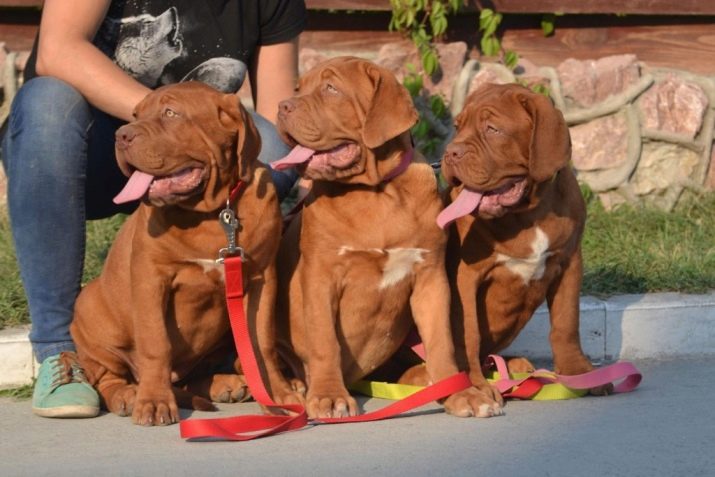
Those owners who live in private houses, in the summertime, sometimes evict the dog to the booth and allow it to run freely around the site as an activity, which turns out to be sufficient for the animal. In winter, the Great Dane is nevertheless taken into the house, and taken out for a walk in the morning and in the evening. In the case when pets show character and do not obey, it is better to contact a dog handler.
For information on how to properly train the Dogue de Bordeaux, see the next video.






































